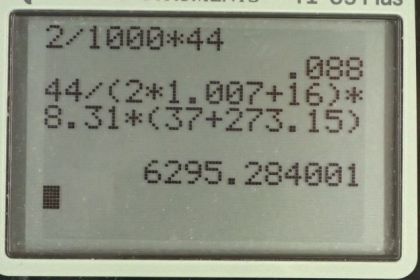Question
Air in human lungs has a temperature of and a
saturation vapor density of . (a) If 2.00 L of air is
exhaled and very dry air inhaled, what is the maximum loss of water vapor by the person? (b) Calculate the partial pressure of water vapor having this density, and compare it with the vapor pressure of .
Final Answer
Solution video
OpenStax College Physics for AP® Courses, Chapter 13, Problem 59 (Problems & Exercises)

vote with a rating of
votes with an average rating of
.
Calculator Screenshots
Video Transcript
This is College Physics Answers with Shaun Dychko. We have to assume that the air that the person is exhaling is saturated. And so it has a vapor density equal to the saturation vapor density for air at 37 degrees Celsius. And that is 44 grams per cubic meter. And so, we multiply this by two Liters but we have to convert the two Liters into cubic meters by multiplying by one cubic meter for every 1000 Liters. And we end up with 8.8 times ten to the minus two grams is the mass of water exhaled in the maximum assuming that they inhale very dry air which has no water in it at all. Now, in part b we're asked to find the partial pressure of water vapor that has this density of 44 grams per cubic meter. Now, we're expecting the answer of 6.31 times ten to the three newtons per square meters, because in Table 13.5 we're told that water has a saturation vapor density of 44 grams per cubic meters at 37 degrees Celsius and a vapor pressure of 6.31 times ten to the three. So, we're just confirming that the vapor pressure value in that table is correct given this saturation vapor density. So, we'll use the Ideal Gas Law to figure out what the pressure will be, and we'll divide both sides by V. And we have the number of moles times this constant times the temperature in Kelvin divided by the volume. So that's 44 grams converted into number of moles. And so we have to look up in Appendix a what the molar mass is of the atoms that make up the water molecule H2O. And so we have two Hydrogen atoms, so we have two times 1.007 grams plus 16.0 grams for the Oxygen in every mole. And multiply that by the gas constant 8.31 Joules per Kelvin and times by 37 degrees Celsius converted into Kelvin by adding 273.15 and that is for every cubic meter, because this number here is 44 grams per one cubic meter. And we put 6.30 times ten to the three newtons per square meter which is pretty much what we expected for our calculation. And so the relative humidity in the lungs is about 100 percent.
